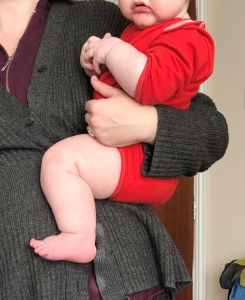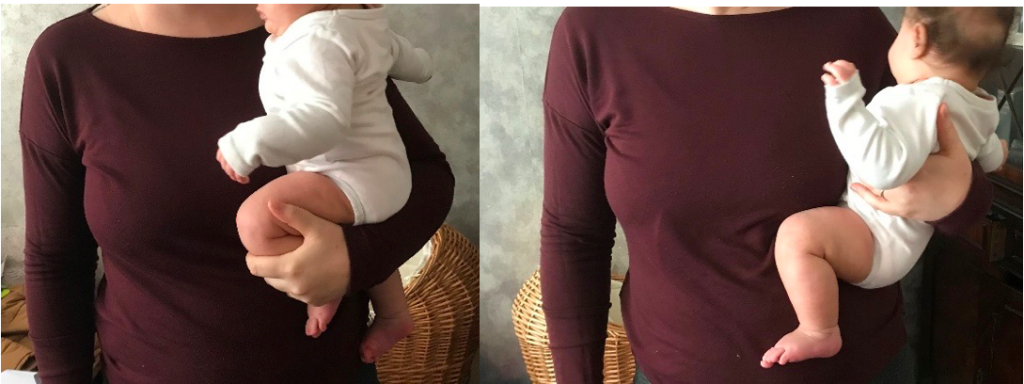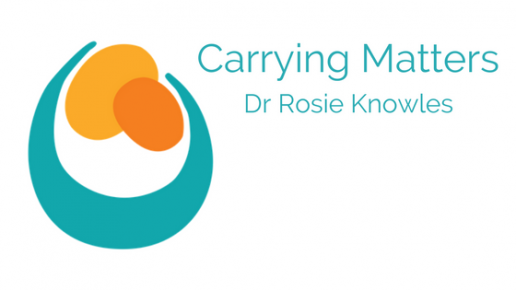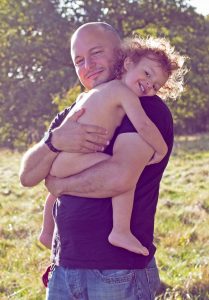Babies can be active participants in being carried, not just passive.
We’ve all held babies that sat well on our hips and balanced themselves, compared to more low-tone babies who just feel like bowling balls. It’s not easy to do, to be sure, as many of us don’t have the strength to do much in arms carrying and then just end up putting baby down… That’s one reason why slings can make such a difference in much of modern life.
However, does in arms carrying matter? Should we do more of it, rather than relying on the baby carrier? My close friend Libby who runs the chiropractic clinic next door to the Snug (where I work) certainly believes so, and so does Mel Cyrille! Mel and I did some babywearing consultant training together several years ago, and she’s become an advocate for in arms carrying. So I asked her some questions about the topic.
1) Tell me a little about yourself and your family.

I’m Mel, mum to four children aged 14, 7, 5 and 2. I live in Ipswich, Suffolk, with my children and husband. I work as a babywearing and in-arms carrying educator through Carried, delivering Consultancy and Peer Supporter courses, with a strong in-arms focus. I’m also an author and public speaker.
2) How did you become interested in “dynamic/active in-arms carrying?”
It all started with my now-5-year old. He had a preference for in-arms carrying, liking it better than slings/carriers. We got off to a great start and were just into the voluntary side of active clinging when I was told how I was supporting him was bad for his spine. Unfortunately, I didn’t question why, and switched to “passive” carrying (providing more support, under the bum and across the thighs), which delayed my learning for a while!
By the time my 4th baby was here I was back on track though. I had read “A Baby Wants to Be Carried” by Dr. Evelin Kirkilionis by this point, and her mention of a few reflexes, and that human babies are “clinging young” piqued my interest. It got me thinking about babies’ in-born abilities, Xander’s initial clinging abilities, and the huge lack of clinging behaviours exhibited in society today. It was a sort of muddling through, testing my theories on Isaac and his brothers, researching and lots of observing how others hold their babies and children, as well as holding other people’s babies myself. Isaac was living proof of how – when we work with their primitive “carrying reflexes” as they learn to perform these actions voluntarily – it is indeed possible to create a strong active clinger. I also found I was able to teach my 2nd child to actively cling and improve Xander’s abilities too.
3) Can you summarise for us the difference between holding babies in arms, babywearing, and active in-arms carrying?
In-arms carrying is both a spectrum of clinging behaviour and a developmental process. Passive carrying (or holding) is where we are doing most of the work to support their weight, and some indicators of this (with some exceptions) are supporting knee-to-knee under the bum, supporting the bum with our arm and “hoiking” up the knee on the front of our body, and full-body contact. Active carrying begins with building up upper-body strength as a newborn and young baby, then working on developing strength in the legs, allowing them to cling to us without supporting bum/legs after this.

[Image description: Left image shows a white-presenting man holding a white-presenting toddler. Toddler is naked and supported by dad’s left arm across thighs and bum. Dad’s right arm holds their lower torso to his body and the toddler leaning into his upper body and resting his head on Dads left shoulder, right arm cuddling Dad’s left arm. Right image shows a cropped picture of the left side of a white mum’s body with her white baby in just a red long-sleeve vest, clinging with his bare legs to her cardigan on her hip. Baby is supported mid-spine by mum’s left forearm.]
Babywearing seeks to mimic in-arms holding, but as fabric behaves in very different ways to arms, babywearing is more passive than in-arms holding, and is a type of baby “container”. Also, we cannot always look at in-arms positioning and replicate in slings/carriers – babywearing and in-arms carrying have different “rules” and are very different things.
Almost every single caregiver carries their baby in-arms, every single day. It’s the most accessible form of keeping babies close – it’s free, it’s necessary and it can be practiced by most people. We can transform this every day practice from being hard work and/or painful as they get bigger, to being easier and comfortable by encouraging our baby/child to do more of the work.
4) We all know the enormous benefits of holding babies and children close and how slings can make this happen as well as making life easier all round. This is something you clearly promote as you’re a babywearing consultant and trainer yourself. How does the more active or dynamic in-arms carrying benefit parents/carers and children?
In-arms carrying is a developmental process and a type of movement. As we know with all other developmental processes, they happen gradually and are important for normal child development. Currently, carrying is not viewed as a developmental process at all – it’s viewed as something we do to/for babies and children, and an inevitable part of moving them from A to B, especially in the first year of life.
Passive carrying is a movement, but not to the same extent as active carrying. When we are doing most of the work, we’re holding them in a static position and some of their muscles relax. Active carrying requires lots of muscle engagement from them, whether that be controlling their upper body, counteracting the many different movements we make as we move around with them, or clinging with their thighs, knees, calves, ankles and feet (or a combination). As we move, they move – it’s a normal type of movement for babies and children, as well as physical exercise for us both.
So, the “benefit” of completing this is simply “normal physical development”, as well as many of the wonderful benefits of babywearing.
For caregivers, a few benefits are that there is the load-bearing for our joints, the comfortableness of a lesser-perceived weight as they feel lighter the more they are clinging to us, and the enjoyment of the interaction and communication that active carrying fosters.
5) Do you have any quick tips for people who want to do some more active carrying?
Sure. It really depends on where the baby is developmentally, and there are different approaches with different dyads as all are unique, but a great starting point is to explore the baby/child’s “biological baseline” for carrying. This is their behaviour when being carried skin-to-skin and from this, they (and us) make adaptions as we factor in layers of clothing and other “barriers” such as nappies and shoes.

The strongest clinging behaviour is elicited skin-to-skin. Not everyone will want or be able to do this, so if you can’t, go for their bare legs on your clothing if you can. Your clothing creates a sensory barrier, but they are still receiving some information and can cling better than if their legs are covered. Doing this is especially great for older babies/children who didn’t learn the voluntary clinging behaviours on-body, as the sensory input from this triggers better clinging and teaches them how their body works. They then begin to transfer this behaviour to clothed carrying, gradually building up their clinging with the hindrance of “barriers”.
In terms of support, the first step is to move that hand from their knee-pit/leg! In younger babies who still have remnants of reflexive clinging behaviours, you may be surprised to see that they are able to cling perfectly well without your “help”. If you’re doing the work, they won’t, and are much more likely to be “conditioned” into passiveness. Where you support them will be dependent on their stage of general physical development, as well as their stage of carrying development. A good starting point would be to only support their bum if you tend to support bum and thighs, or gentle support at the base of their spine with your forearm if they are able to cling for periods of time like this.

Also, be aware of your posture and alignment. Just as with babywearing, carrying can have negative effects on your body. Western carrying in the general population is full of hip-jutting, rib-thrusting and pelvic-tilting. Removing these “bracing points” where possible will both protect your body better and encourage them to cling more.
It’s important to remember that if you’re working with babies who have already integrated certain reflexes but haven’t learned the corresponding on-body behaviours, they will not perform certain actions and will need to be taught what to do. For example, once the “stepping reflex” (or “clinging adjustment reflex”) is integrated, they will either consciously adjust their legs/lower body as the leg/s slip, but if they’ve not been using this reflex in carrying and learned the voluntary actions, they will just dangle once they slip. In this case you would be regularly adjusting their body back into position, and they would gradually learn to correct their posture themselves over time.
6) Is there any specific research into this area yet?
Into active in-arms carrying? I wish! It’s made things much harder in terms of “backing up” the obvious with “science”. There are bits and pieces of research into various things which make up in-arms carrying, which I reference in my book, but until it’s recognised as a developmental process in its own right, I think we’re unlikely to see any specific research into active carrying any time soon.
7) How can people find out more about this fascinating topic if they wish to?
I wrote a book on the subject – “In-arms Carrying” – which is a basic introduction to many of the aspects which make up and/or affect carrying. It’s available in paperback and on Kindle. I have a website too, In-arms Carrying. I also run courses on the subject and am currently writing my second book, which delves much deeper into the scientific aspects and lots of amazing stuff I want to talk about to do with it! Occasionally I blog, and you can follow my work on Facebook and Instagram.
For some tips on protecting your body when holding your baby, biomechanist Katy Bowman has a couple of videos on Youtube.
My friend and colleague, Ulrika, and I have recently started a podcast. We discuss different aspects of in-arms carrying and in future will also include other topics such as babywearing, elimination communication, baby communication and more. Transcripts are available for those unable to tune in/prefer reading.


